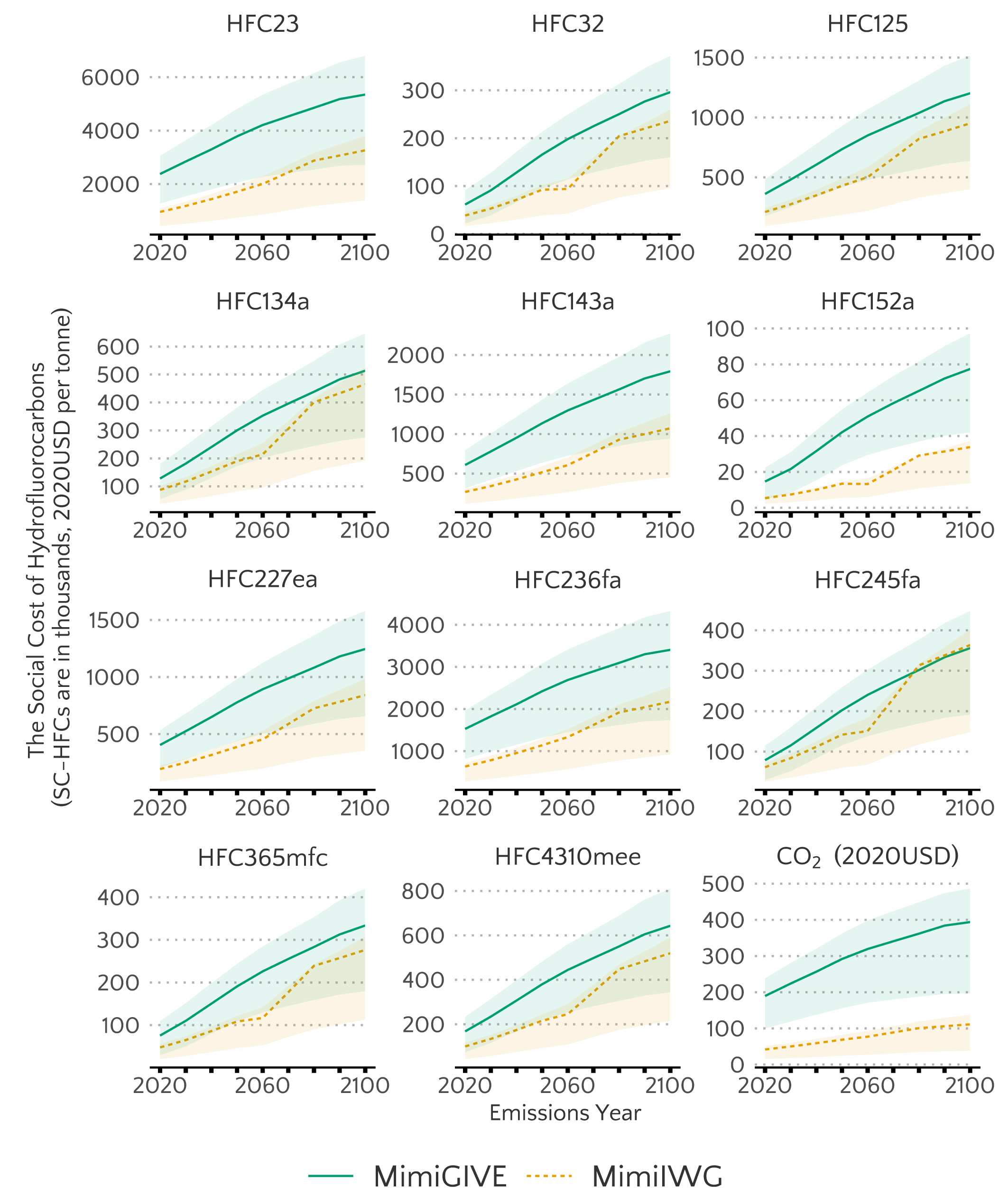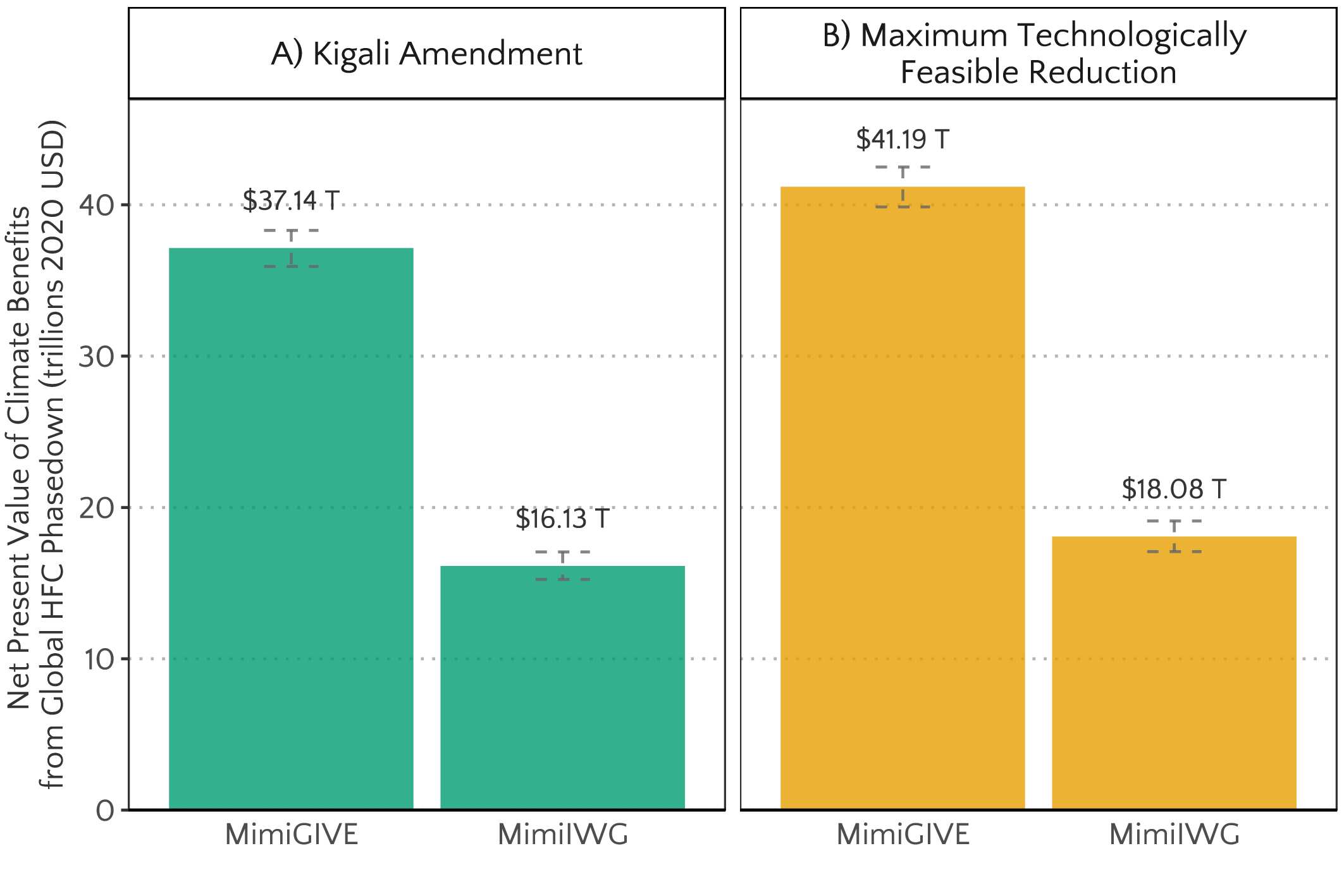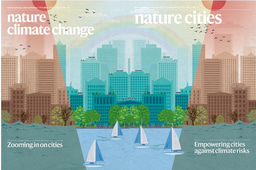The Social Costs of Hydrofluorocarbons and the Benefits from their Expedited Phase-down
Published in Earth & Environment, Economics, and Law, Politics & International Studies

On a hot summer’s day, an insulated, air-conditioned room provides a welcome reprieve from the heat. Yet a core class of chemicals used in these cooling technologies – hydrofluorocarbons – are, somewhat ironically, potent contributors to rising global temperatures. Quantifying the social costs associated with hydrofluorocarbon emissions situates them in existing policy frameworks and helps decision-makers consider the costs and benefits of their mitigation. In this study, we calculate the present value quantified future damages from their emissions, also known as the social costs of hydrofluorocarbons, and estimate the climate benefits associated with global phasedown agreements.
Hydrofluorocarbons – a potent greenhouse gas
Hydrofluorocarbons (HFCs) are a class of industrial chemicals used primarily for refrigeration, air cooling and heating, insulating foams, and aerosol propellants. They were developed as replacements for the ozone-depleting substances being phased out under the Montreal Protocol. While HFCs do not contain ozone-depleting chlorine or bromine, they are nevertheless a potent greenhouse gas that contributes to climate change.
Experts forecast that global warming itself will exacerbate the demand for cooling technologies around the globe, creating a dangerous feedback loop. HFC emissions increased by 23% from 2012 to 2016 alone and, without policy intervention, growth is projected to continue – especially in developing countries.
Estimating the social cost of HFCs
The United States Government publishes official estimates of the social cost of carbon dioxide (SC-CO2), methane (SC-CH4), and nitrous oxide (SC-N2O), that are used to value changes in emissions of these greenhouse gases in a benefit-cost framework. Estimates of the social cost of HFCs (SC-HFCs) similarly enable assessment of climate benefits and damages associated with HFC emissions.
Prior to our study, calculating the SC-HFCs often relied on approximations based on global warming potentials. While this method provides a simple and popular heuristic for estimating SC-HFCs, it has been subject to various criticisms such as such as its applicability in benefit-cost analyses, sensitivity to the time horizon and discount rate, and the dynamic relationship between changes in climate forcing and economic damages. Methods that estimate social costs directly, such as those developed in this study, circumvent many of these limitations. Additionally, estimating SC-HFCs in a manner consistent with the U.S. Government’s methodology promotes consistency in their application to policymaking tools such as benefit-cost analyses.
This study presents SC-HFCs directly estimated using the same suite of three integrated assessment models adopted by the U.S. Government (DICE, FUND, and PAGE), collectively referred to as MimiIWG, as well as for a new open-source model, the Greenhouse Gas Impact Value Estimator, MimiGIVE, which incorporates many recent scientific advances and recommendations outlined in a 2017 report by the National Academies.
We calculate the SC-HFC for eleven HFCs in a probabilistic modeling setting that uses a Monte Carlo approach with 10,000 simulations of each model to account for all quantified parameter and structural uncertainties. Annual streams of marginal damages – damages associated with a one tonne increase in HFC emissions – are discounted back to the year of emissions at the central discount rate for each model. We find that the estimated SC-HFCs for an emissions pulse in 2023 from MimiIWG are 24-65% lower than the estimates under the updated MimiGIVE model.
 Fig. 1 | The Social Cost of Hydrofluorocarbons. The mean SC-HFCs (lines) along with their 5th to 95th percentile ranges (shaded ribbons) are shown. The SC-HFCs from MimiIWG adopt a 3% constant discount rate, while MimiGIVE adopts a calibrated Ramsey-like discounting framework with a near-term target discount rate of 2%. SC-HFC values are in 2020 U.S. dollars.
Fig. 1 | The Social Cost of Hydrofluorocarbons. The mean SC-HFCs (lines) along with their 5th to 95th percentile ranges (shaded ribbons) are shown. The SC-HFCs from MimiIWG adopt a 3% constant discount rate, while MimiGIVE adopts a calibrated Ramsey-like discounting framework with a near-term target discount rate of 2%. SC-HFC values are in 2020 U.S. dollars.
A global agreement to phase down HFCs
The Kigali Amendment to the Montreal Protocol is the first global agreement to explicitly phase down HFC production and consumption. It was implemented in 2016 and aims to reduce HFC production and consumption by up to 85% from baseline levels by 2045. The Kigali Amendment is expected to avoid an increase in atmospheric temperature of about 0.2-0.4°C by the end of the century, but has nonetheless faced criticism from some who believe that it is not ambitious enough, claiming that sufficient progress towards climate goals like the Paris Agreement necessitates a more aggressive phasedown or full phaseout of HFCs.
We use emissions projections from Purohit et al. (2020) to calculate the climate benefits from the Kigali Amendment under the current phasedown schedule and compare this to a scenario that implements an accelerated, maximum technologically feasible, reduction schedule which includes a full phaseout of HFCs by 2035. We find that climate benefits from the as-published Kigali Amendment range from $16.13 trillion ($15.24T–$17.06T, 5%–95% range, 2020 U.S. dollars) using the SC-HFCs from the MimiIWG framework to $37.14 trillion ($35.93T–$38.31T, 5%–95% range, 2020 US dollars) using the MimiGIVE estimates. This is an increase of approximately 130% when using MimiGIVE relative to MimiIWG.
Under the accelerated phasedown schedule, total climate benefits range from $18.08 trillion ($17.08T–$19.11T, 5%–95% range, 2020 U.S. dollars) using the SC-HFCs from the MimiIWG framework to $41.19 trillion ($39.86T–$42.50T, 5%–95% range, 2020 US dollars) using the MimiGIVE estimates. Under both modeling frameworks, we estimate an additional 11-12% in climate benefits from adopting the more aggressive global phasedown schedule.

Fig. 2 | The total climate benefits from phasedown of hydrofluorocarbons. MimiGIVE estimates are calculated assuming a calibrated Ramsey-like discount rate using a near-term target of 2%, while MimiIWG assumes a constant 3% discount rate.
What are the implications?
As we approach the 10th anniversary of the Paris Agreement, providing policy makers with more advanced tools to better evaluate the tradeoffs associated with policy decisions is increasingly valuable. Our MimiIWG model provides estimates of SC-HFCs that are consistent with the U.S. Government methodology, while our MimiGIVE model reflects recent scientific advancements in socioeconomic projections, climate science, impact estimation, and discounting approaches.
The results from our analysis of the Kigali Amendment indicate that the climate benefits from following through with the international agreement are large. Furthermore, pursuing a full phaseout of HFCs could provide trillions of dollars in additional climate benefits and catalyze accelerated progress towards achieving global climate goals.
Follow the Topic
-
Nature Climate Change

A monthly journal dedicated to publishing the most significant and cutting-edge research on the nature, underlying causes or impacts of global climate change and its implications for the economy, policy and the world at large.



Please sign in or register for FREE
If you are a registered user on Research Communities by Springer Nature, please sign in